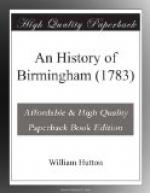We include the warehouse, then of John Jenens, Esq; now No. 26, in High-street, penetrate through the buildings, till we come within twenty yards, of Moor-street, turn sharp to the left, cross the lower part of Castle-street, Carr’s-lane, and New Meeting-street; pass close by the front of the Meeting-house, through Bank-alley, into Hen’s-walk, having kept Moor-street about twenty yards to the right, all the way; we now enter that street, at the bottom of Hen’s-walk, pass through the east part of Dale-end, through Stafford-street, Steelhouse-lane (then called Whittal-lane) Bull-lane (then New-hall-lane) and Mount-pleasant.
Our journey now leads us on the west of Pinfold-street, keeping it about twenty yards on our left; up Peck-lane, till we come near the top, when we turn to the right, keeping the buildings, with the Free-school in New street, on our left, into Swan-alley. We now turn up the Alley into New-street, then to the right, which leads us to the Party-wall, between No. 25 and 26, in High-street, late Jennens’s, where we began.
In the new parish I have described, and during the journey, kept on the left, there seems to have been, at passing the act, twelve closes, all which are filled with buildings, except the land between New-street and Mount-pleasant, which only waits a word from the owner, to speak the houses into being.
The church was consecrated in 1715, and finished in 1719, the work of eight years; at which time the commissioners resigned their powers into the hands of the diocesan, in whom is the presentation, after having paid, it is said, the trifling sum of 5012_l_.—but perhaps such a work could not be completed for 20,000_l_.
Three reasons may be assigned, why so small a sum was expended; many of the materials were given; more of the carriage, and some heavy debts were contracted.
The urns upon the parapet of the church, which are highly ornamental, were fixed at the same time with those of the school, in about 1756.
When I first saw St. Philip’s, in the year 1741, at a proper distance, uncrowded with houses, for there were none to the north, New-hall excepted, untarnished with smoke, and illuminated by a western sun, I was delighted with its appearance, and thought it then, what I do now, and what others will in future, the pride of the place.
If we assemble the beauties of the edifice, which cover a rood of ground; the spacious area of the church-yard, occupying four acres; ornamented with walks in great perfection; shaded with trees in double and treble ranks; and surrounded with buildings in elegant taste: perhaps its equal cannot be found in the British dominions.
The steeple, ’till the year 1751, contained a peal of six bells, which were then augmented to ten; at which time St. Martin’s, the mother church, having only eight, could not bear to be out-numbered by a junior, though of superior elegance, therefore ordered twelve into her own steeple: but as room was insufficient for the admission of bells by the dozen, means were found to hoist them tier over tier. Though the round dozen is a complete number in the counting-house, it is not altogether so in the belfry: the octave is the most perfect concord in music, but diminishes by rising to an octave and a half; neither can that dozen well be crowded into the peal.




